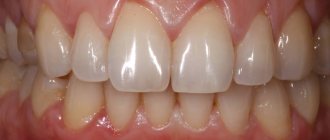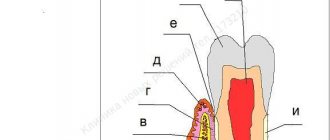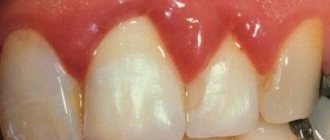An “attractive smile” means not only straight and snow-white teeth, but also the correct contours of the tissues that frame the dental crowns. Unfortunately, their outlines are far from always ideal. If you are unhappy with your gum contour, contact your dentist for a plastic surgery procedure, which has become quite common in modern practice.
To perform gum surgery, local anesthesia is sufficient. The doctor can use either a scalpel or a laser. What exactly would be the optimal solution in your case, the specialist will decide during the examination. As a rule, to outline the desired result, the doctor draws the future gum line on the teeth.
The operation is performed by a periodontist. Before doing this, be sure to make sure that the specialist is qualified and look at examples of work he has already carried out.
Plastic surgery for gum recession
Gum recession can occur as a result of a number of periodontal diseases. The soft tissue becomes smaller and the tooth root is exposed. This is not very aesthetically pleasing, and can lead to a number of problems, including tooth loss. Recession can develop on one tooth or on several.
In addition, due to an overly short and powerful frenulum or insufficient vestibule of the oral cavity, the free edge of the gum can peel off, gum pockets form and inflammation begins. The vestibuloplasty procedure can solve this problem. During the operation, the vestibule of the oral cavity is deepened, and soft tissues are distributed in this area more rationally.
To restore the required volume to the soft gum tissues, cover exposed roots, prevent the development of caries and aesthetically improve the smile, a gum augmentation procedure is performed. It can concern either exclusively the epithelium and connective tissue, or affect the periosteum. It depends on the specific situation.
Reasons for changing the size of the flushing hole
The gap may increase for the following reasons:
- tissue inflammation, accompanied by periodontal destruction (can occur when the immune system is weakened, as well as along with allergic manifestations and oral infections);
- violation of the sealing of the fixing elements of the orthopedic structure;
- damage to the integrity of the bridge at the junction with the crown (even minor damage to the prosthesis leads to its displacement and subsequent impact on the tissue around the tooth);
- poor oral hygiene and inflammation of the gums leads to their enlargement, due to which the rinsing hole is reduced;
- improper preparation of the oral cavity (poor sanitation, etc.) leads to damage to the enamel, due to which the gums rise above the coronal part;
- periodontal diseases, which entails a change in the original position of individual elements of the dentition.
Errors by the dentist or non-compliance with the technological process when installing a prosthesis can result in either an increase in the rinsing space or its complete absence.
Reference! Fixing the bridge too tightly increases the risk of injury to the gums in all parts of the oral cavity. Insufficient fit of the prosthesis, in turn, can lead to impaired speech functions, cause difficulties while eating and even difficulty breathing.
Deviation of the planting density from the norm is fraught with rapid damage to the structure beyond the possibility of repair.
Gum grafting against “shark” and “gummy” smiles
The shape of the gingival contour depends on a number of factors. Thus, hereditary predisposition, certain diseases and the use of certain medications can cause hypertrophy of soft tissues. This is how a “shark smile” appears, and the teeth visually lose size. To solve this problem, a gingivectomy procedure is performed. Excess tissue is excised. The doctor removes gum pockets or hoods that often form during the eruption of wisdom teeth. After excision, an optimal contour is created.
Gum plastic surgery is often used to correct a “gummy smile.” This is the name of a smile in which the upper gum is exposed by more than two millimeters. In this case, excess soft tissue is eliminated, and with the help of a doctor, the gum contour takes on a beautiful, correct appearance.
How is an overgrown tooth removed?
Root extraction is a fairly common dental operation. It is performed under local anesthesia and, as a rule, does not cause complications. An overgrown root cannot be removed using traditional methods, since it is completely covered with gum tissue and there is no access to it. Treatment is carried out in several stages:
- Examination by a dentist, x-ray examination. X-ray allows the doctor to see the size, position, and depth of the root. The dentist assesses the risk of damage to adjacent teeth during surgery.
- The operation is performed under anesthesia. First, the doctor makes an incision in the gum, providing himself with access to the root. After this, the root is removed and sutures are applied.
- During the rehabilitation period, the doctor selects anti-inflammatory drugs and agents that accelerate wound healing.
The process of removing an overgrown root is individual in each case. The complexity of the operation is influenced by many factors:
- Tooth location. Removal of roots on the upper and lower jaws has its own characteristics and is carried out using various dental instruments.
- The degree of damage to the root and nearby tissues, the presence of fragments. Sometimes, for a successful and as painless removal for the patient as possible, the root is destroyed by a drill into several parts. Separation is required in cases where the tooth has several strong, deep roots. As a rule, after destruction, individual parts are easily removed using ordinary tools.
- The presence of pathology in the surrounding bone tissue, inflammation of the gums.
If you have a problem similar to that described in this article, be sure to contact our specialists. Don't diagnose yourself!
Why you should call us now:
- We will answer all your questions in 3 minutes
- Free consultation
- The average work experience of doctors is 12 years
- Convenient location of clinics
Single contact phone number: +7
Make an appointment
If there is no inflammation, the gum is carefully separated from the alveolus and the tooth is removed using suitable dental forceps. The inflammatory process “melts” the surrounding tissue, so for successful removal it is enough to provide access to the root by making an incision in the gum. Application of forceps does not require labor, and there is no need to additionally separate the gingival tissue from the alveoli. In difficult cases, elevators are used.
How gums heal after plastic surgery
Depending on the nature of the operation, gum tissue is restored within a period of several days to several weeks. The doctor provides you with a list of recommendations that must be followed for a speedy recovery. You will also be prescribed anesthetics.
In the postoperative period, physical activity and hard, too hot or cold foods are contraindicated. We'll have to forget about spicy dishes for a while. Of course, standard daily hygiene procedures cannot be ignored. Until the tissues have completely healed, it is recommended to wear a special mouth guard.
Tissue swelling after plastic surgery persists for several days, but, as a rule, it subsides after the third day. If this does not happen, and in addition headaches, bleeding and other suspicious symptoms occur, you should contact your dentist as soon as possible.
Gum grafting is a surgical procedure with its share of risks. The most common ones include an allergic reaction to painkillers and relapse of gum recession. In the first case, you should warn the specialist in advance about a possible allergy; in the second, you will need to repeat the procedure after six months.
Basic recommendations after gum incision
Implantation, tooth extraction, or opening of purulent foci is not possible without an incision in the gums. This stressful situation for the oral cavity causes considerable discomfort for a person.
Recommendations after gum incision:
- On the first day, you need maximum peace and rest;
- For 3 hours, all drinks and food should be excluded;
- In the first 3 days, hard and hot foods should be excluded, as well as excessive facial expressions;
- Any physical activity, especially those leading to blood flow to the head, should be avoided;
- Also, exclude hot relaxing baths, saunas and steam baths;
- For 7 days you need to strictly limit your intake of tobacco and alcoholic beverages;
- It is strictly forbidden to apply hot compresses to the wound or cauterize it with alcohol-containing solutions.
What to do if complications arise after gum surgery:
- Edema. Always occurs during implantation or after removal of a wisdom tooth. Small to medium edema is a normal reaction of the body. If the swelling is severe, then you need to consult your doctor to rule out the onset of alveolitis.
- Temperature. The temperature that rises a few hours after the gum incision can reach 37.5 °C, which is considered normal. However, if it goes beyond 38 °C, it may indicate the onset of the inflammatory process. In this case, you should consult a doctor to prescribe a course of antibiotics.
- Bleeding. After surgery, a blood clot usually forms to prevent bacteria from entering the socket. Bleeding occurs as a result of vascular damage or capillary fragility. To stop the bleeding, apply a thick sterile bandage to the problem area. If the bleeding does not stop, you should call a doctor.
- Pain. Natural response to surgery. The pain can be moderate or very severe. In any case, to reduce it you need to take a painkiller pill.
Dental clinic Stomatolog 11 in Moscow offers a wide range of services in orthodontics, therapeutic dentistry, and implantation. It is also popular to make an appointment with a pediatrician and for teeth whitening.
Treatment using innovative dental devices and careful attitude towards each client allows us to minimize the risks of any complications after dental interventions. You can see the work performed by a team of true professionals in the photos posted on our website and in social groups.
Choose high-quality and safe dental services in our clinic. Ensure your dental health.
Free consultation
Gingivotomy: indications
Indications for gingivotomy include:
- inflammatory processes;
- preparation for dental prosthetics;
- deep periodontal pockets;
- gingival fistulas;
- abscesses, relapses of abscesses;
- periodontitis with prolonged discharge of pus;
- generalized periodontal diseases;
- the so-called gummy smile.
During the consultation, the doctor will explain whether intervention is advisable in a particular case or whether conservative treatment is possible.
Types of surgery
At the preparatory stage, professional teeth cleaning is required. This is necessary to destroy plaque and food debris trapped in periodontal pockets. Immediately before the operation, local anesthesia is administered. The dentist performs a series of sequential actions in accordance with the chosen method. There are three main ways to perform a gingivectomy.
Simple means:
- Wave-like dissection of the gums and periosteal tissue at the site of inflammation.
- A similar cut is made from the inside.
- At the ends of each of the incisions, vertical cuts are made.
- The gum is separated and needs to be eliminated.
- Curettage of the bone cavity and wound surface is performed.
- A bandage is applied, which the patient wears for up to 48 hours.
Gentle - almost the same as the previous one. The difference is that in this case, not the entire wall of the pocket between the tooth and the gum is cut, but only part of it (no more than 3 mm). Then curettage is also carried out on the remaining part of the gum tissue.
Radical - refers to complex surgical procedures, since the tissue of the alveolar arch of the jaw is involved in the process. In this case, wave-shaped incisions are also made, after which the gum edge is removed along with epithelial cords, granulation tissue and affected areas of bone. At the last stage, a gum bandage is applied to promote rapid healing.
The main causes of pathology
There are a number of main reasons why a tooth can become overgrown with soft tissue. The most common reason is negligence towards periodontal tissues, refusal to visit the clinic after breaking off part of the crown. There are also quite often cases when a wisdom tooth that has not fully erupted is covered with gum on top. In the future, this figure eight can exert strong pressure on the entire dentition, which will lead to a gradual change in the bite and the appearance of serious orthodontic pathologies.
The patient may also encounter a similar situation when refusing to remove the root system of a broken tooth. As a result, a small piece of the top, as well as the root, remains under the gum, and over time they can begin to hurt and become inflamed.
It is important to note that a person’s bad habits, poor diet, consumption of junk food, chronic diseases and lack of oral hygiene can lead to teeth becoming more sensitive and brittle. As a result, the slightest pressure will be enough to cause part of the crown to break off.









